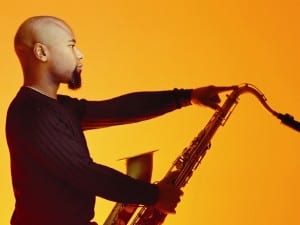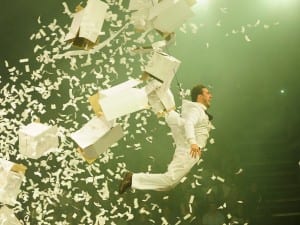Puppet Animation Scotland and Manipulate support and explore the crossover between puppet theatre and animated film, breaking the boundaries and encouraging a wider audience.
To animate an object is to imbue it with life and movement: it is a primary facet of the art of puppetry but is also a central requirement of animated film, where static images are given motion. The connection between these two otherwise diverse art forms is something that is receiving more attention now than ever. This is particularly true in Scotland, thanks to the work of Puppet Animation Scotland. An organisation which is dedicated to the development and promotion of all forms of animation and puppetry in Scotland, they foster creativity and offer professional support to practitioners. In addition to their many training and funding opportunities, they also run a festival.
This festival, manipulate, is held annually at venues around Scotland and is a unique showing ground for all manner of visual theatre, puppetry and animated film. Gathering international work together in a festival like this has proved important in demonstrating both the vast number of high quality productions being created and in assuring would-be practitioners that there is an established audience for their work. The festival had an original focus on puppetry but in recent years has extended its remit to include a growing animation programme as well as other visual art forms such as aerial theatre.
The work is unified by its visual quality as well as the notion of imbuing something static with movement and life. The animation of objects with the qualities of life, intention and emotion is the central focus. Simon Hart, artistic director of manipulate and of Puppet Animation Scotland, talks about how the early work of theatre company 1927 led them towards programming a standalone selection of animation: “They used a combination of live performance and animation and it just seemed like a natural step.” The last three or four years have seen the animated film aspect of this visual theatre festival, now in its eighth year, grow ever larger.
A stronger partnership with Edinburgh College of Art has helped facilitate this new direction and the work on offer now extends to educational and developmental workshops and talks, as well as performances: manipulate invites leading international animators to come and talk about their own work and artists that inspire them. The presence of the festival in Edinburgh and at various other venues throughout Scotland has been a great incentive for Scottish artists to experiment and embrace animation, puppetry and other various styles and techniques. The team at manipulate supports a number of Scottish companies to tour around the world and has managed to inspire and influence Scottish theatre practitioners creating new work.
Part of this has simply been to open doors into other aspects of theatre for some artists: links with the Norwich Puppet Theatre, for example, have offered “a great training ground for many leading Scottish puppeteers”, and Simon Hart thinks that there is a much greater awareness of international opportunities among artists in these fields than there was before. He is enthusiastic about Scotland’s ever-growing position in the international world of animation as well: “There’s so much great work coming out of colleges. Edinburgh College of Art is producing real world-class animators and the sheer amount and the range of work is exciting.”
Variety is definitely something endorsed by manipulate: the selection of work at this year’s festival is as diverse as aerial dance from American company Paper Doll Militia (Unchained), traditional Bunraku puppetry from Sandglass Theater and Andrea Miltnerova’s Dance of the Magnetic Ballerina, a thrilling combination of dance, sound and interactive lighting. While it may be difficult for some to marry the idea of dance with puppetry, Miltnerova’s work also combines use of silhouette, an ancient technique in shadow theatre (possibly the closest crossover between puppetry and animated film, since it involves the projection of images upon a surface in much the same manner as film). Hart explains that he programmes dance work “where you are seeing the performer being, in essence, their own puppet and their own puppeteer.”
Relationships lie at the heart of theatre and this codependency between puppet and master is fascinating: in addition to the emotion and story being portrayed on stage, the manipulation required to tell the story and to animate the characters offers an extra dimension with many surprising elements.
There is always a silent dialogue between object and puppeteer that speaks of notions of power, control and mutual reliance. The very best of meta-puppetry incorporates these very issues right into the heart of the story, such as in Boris and Sergey’s Vaudevillian Adventure. This ambitious show by Flabbergast Theatre contains a “birth” sequence where the puppet Boris is “born” – he soon notices the people clinging onto and controlling his limbs and attempts to break free of his bonds, only to realise that his captors are also his liberators, as without them he is unable to move.
The pieces showcased in manipulate express a similar duality to that seen in Boris and Sergey: many of them deal with themes of imprisonment or oppres- sion, and the work Unchained sees the performers trapped by chains in much the same way as a puppet might be confined by its strings. The stories are about creator and creation (as in the retelling of Frankenstein by Spotted Stripes Circus, Welcome My Son) as well as the power and symbolism of objects. Velo Theatre’s And Then He Ate Me is a great example of a show that puts an object as its centrepiece and then animates it by the creation of emotion and experience rather than through physical movement. Although not all the productions at manipulate are puppetry, all of them are influenced by the notions and ideas that the art of puppetry contains.
Even the boundaries between physical and digital animation are not so clearly drawn as may seem to be the case. Hart suggests that a number of animators find their way to the medium from craft backgrounds or visual art and perhaps this lends a certain physicality to their work. Indeed, the use of stop-motion animation in Scottish filmmaker Claire Lamond’s work is a great example of a film format that retains a close connection to the on-stage animation that occurs in puppetry. Other artists and practitioners can be seen as challenging the distinction in other ways: Clydebuilt Puppet Theatre, for example, explore overhead projection and animate drawings live, while Ludens Ensemble demonstrate their use of 3D mapping in theatre.
Hart believes that spectators are increasingly hungry for this kind of work: “I think that we are so much more graphically literate and sophisticated in our visual awareness and acuity. Ours is a relatively young audience looking for something that will inspire them and engage their optical senses as much as their intellectual and emotional sense.”
This is a market of young people raised on films, regularly active on Instagram and Vine and who participate in visual media all the time; it is totally second nature to them and part of their daily sphere of communication. The aesthetic quality of work is important to them. In an ever-unifying world, visual theatre, animation and puppetry also provide an experience that relies less on words and therefore can be more universally enjoyed, while still allowing space for different and individual interpretations and responses.
It’s a fascinating time for theatre, and, with festivals such as manipulate working hard to break down the boundaries between film and live performance, animation and visual production is attracting an ever-growing audience and offering new and interesting ways for practitioners to tell stories, layering emotions and relationships on top of one another and questioning the roles of creator and creation. Make 2015 the year to experience more puppet theatre and to support animation – the innovation is endless.
Manipulate runs until 7 February at the Traverse Theatre and Summerhall in Edinburgh. There will also be select performances at The Lemon Tree in Aberdeen, The Big Burns Supper in Dumfries and Norwich Puppet Theatre later this spring. For tickets and more information about the festival, please visit www.manipulatefestival.org and www.puppetanimation.org.
Bryony Byrne





